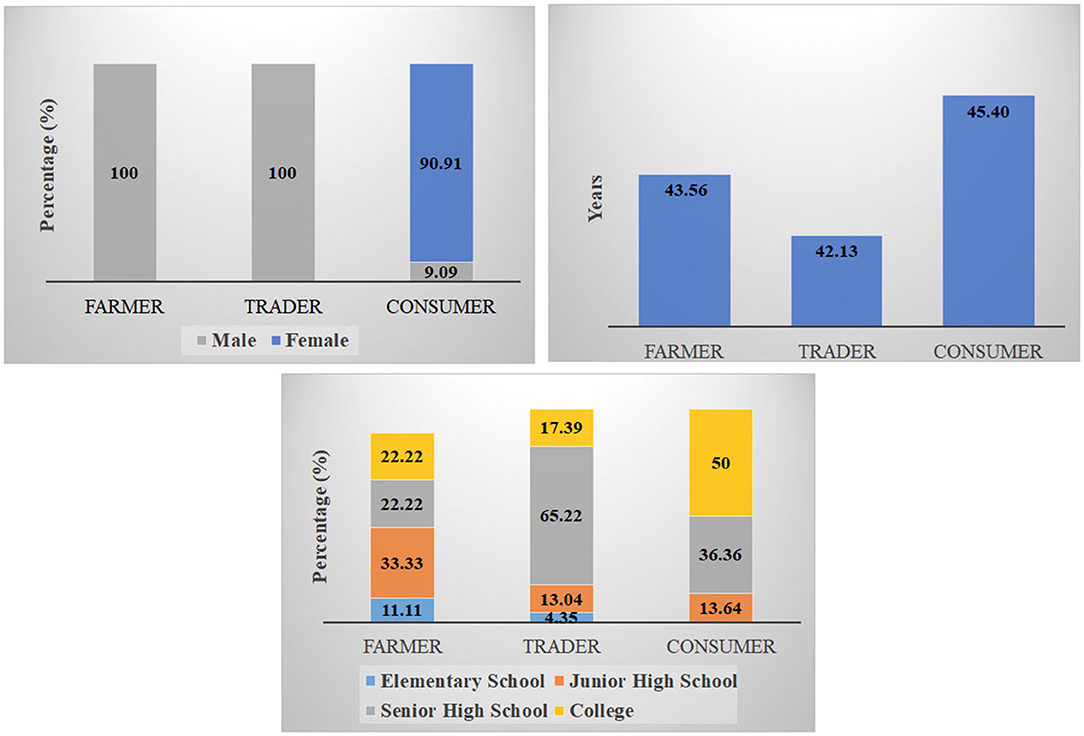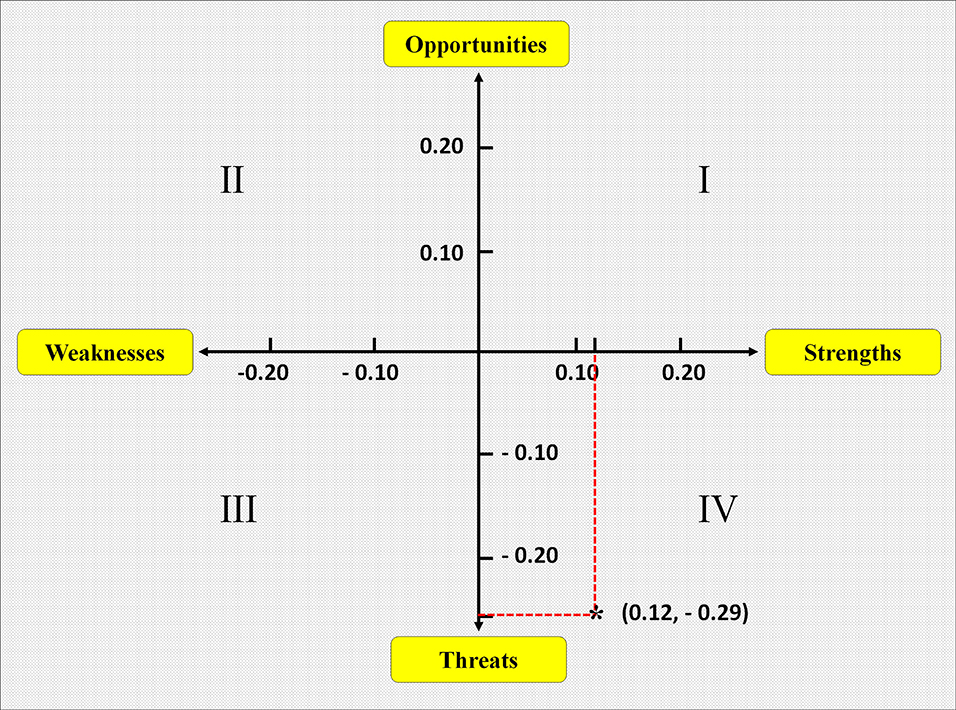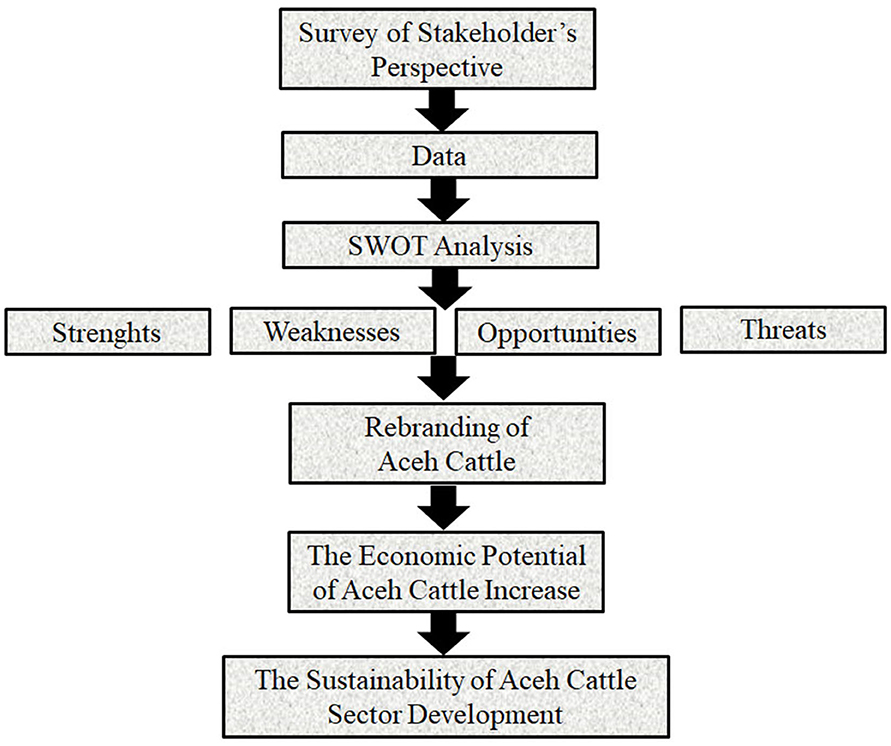- 1Physiology and Pharmacology Study Program, IPB University, Bogor, Indonesia
- 2Laboratory of Anatomy, Faculty of Veterinary Medicine, Syiah Kuala University, Banda Aceh, Indonesia
- 3Department of Animal Infectious Diseases and Veterinary Public Health, Faculty of Veterinary Medicine, IPB University, Bogor, Indonesia
- 4Department of Anatomy, Physiology, and Pharmacology, Faculty of Veterinary Medicine, IPB University, Bogor, Indonesia
- 5Department of Animal Production and Technology, Faculty of Animal Science, IPB University, Bogor, Indonesia
This study aims to evaluate the economic potential of Aceh cattle from the perspective of stock farmers, traders, and consumers as the three main players in the business. This study was conducted from June to August 2018 in Banda Aceh City and Aceh Besar District, Aceh Province, Indonesia. It used related literature and a survey method that involved interviews, observations, and questionnaires from 9 stock farmers, 23 traders, and 22 consumers to obtain data. The data presented descriptively and analyzed using SWOT (strengths, weaknesses, opportunities, and threats) analysis. The results show that the strength factors of the Aceh beef business are high selling prices, easy maintenance, the good taste of meat, and that do not shrink quickly when cooked. Meanwhile, the weakness factors are the limitation of the availability of seeds, traditional methods of assessing carcass weight during the buying and selling process, and the low productivity of the cattle compared with other breeds. The factors that become opportunities include the high demand for the beef, on both weekdays and religious holidays, the selling price tends to increase each year, and the government's commitment to increase local cattle productivity through various programs. However, there are certain threats to the development of these cattle, and they include the high price of calves, competition with other more productive breeds, the existence of other cheaper sources of animal protein, and a decrease in consumer purchasing power. The difference between the value of the strength and weakness factors was 0.12, which signified a positive result, while that between the opportunity and threat factors was −0.29, which signified a negative result. Furthermore, the coordinate value from the Cartesian field shows that the development of these cattle is in quadrant IV, which means that the prospect for development is still quite high, regardless of the threat. In conclusion, Aceh cattle have a high economic potential to be developed, which needs to be strengthened through the rebranding program while at the same time maintaining the sustainability of the Aceh cattle breed in Indonesia. Meanwhile, the government is expected to supervise and regulate the trade of these cattle to provide beef at an affordable price for consumers.
Introduction
Indonesia is one of the importer countries of live cattle and beef due to insufficient meat from local cattle production. The total national demand for beef in 2019 reached 679,000 tons, while beef production in 2018 was estimated to be only 496,000 tons. The imbalance between local supply and demand became the reason why the government has to import the meat and also live cattle from abroad. The imports of fresh and frozen meat and live cattle by the Indonesia government reached around 160,000 tons in 2018 (Statistic Indonesia, 2019). The inadequacy of domestic meat production provides a potential cattle farming business opportunity. However, the development of the livestock industry in Indonesia has not met the target plan. The same problems are faced by the livestock sector in Africa. Animal productivity is less than optimal in most cases and is faced numerous challenges including limited access to adequate nutrition and disease management, poor institutional capacities, and lack of adequate government policies and funding to develop the livestock sector (Ibeagha-Awemu and Zhao, 2019).
Aceh cattle as one of Indonesia's local genetic sources have been recognized as a source of meat supply in Aceh Province. Aceh cattle have been determined as the Indonesian local cattle family through Minister of Agriculture Decree Number: 2907/Kpts/OT.140/6/2011 dated June 17, 2011 (Ministry of Agriculture, Republic of Indonesia, 2011). Aceh cattle farming has existed from generation to generation related to socio-culture of the local community in Aceh Province. Aceh cattle are known to have pre-eminence characters such as having good adaptability to the climate in Indonesia, being resistant to tropical disease, being easy to rear, and having a good selling price (Sari, 2011; Mirza and Rahayu, 2017; Silalahi et al., 2019). Aceh cattle raising does not take a long period because it is included in the group of small size cattle (Mirza and Rahayu, 2017). This pre-eminence made Aceh cattle farming potential to be developed from smallholder into large-scale business (Noor, 2008). Unfortunately, the Aceh cattle breeding and farming have not yet developed because it is still being carried out through a traditional farming method on a household scale.
The previous studies have identified various problems related to the development of the Aceh cattle business, and the solution that has been given was a development model based on the area (Saputra et al., 2009). However, these problems have not been able to be solved, as indicated by the slow rate of the Aceh cattle business. The absence of population, reproductive, and productivity data of the Aceh cattle is predicted to be the obstacle to the development of Aceh cattle. The population data of Aceh cattle currently have not been clear. The available data that can be accessed are only the whole beef cattle population. The total population of beef cattle in Aceh Province (including Aceh cattle) reached 627,698 cattle in 2017. It was reported that there was a decreasing percentage of the beef cattle population estimated to be 1.97% or became 603,415 cattle in the total of beef cattle population in 2018 (Statistics of Aceh Province, 2019). The decreasing number of population is presumably caused by a declining number of the Aceh cattle population because this breed is the dominant cattle breed in Aceh Province. The stagnancy of the Aceh cattle business is also caused by the low quality of the breeding system, poor farming management, and limitation of Aceh cattle genetic enhancement, which is solely based on phenotypic data through production records (Putra et al., 2015) and morphometric data (Abdullah et al., 2007). All these problems must be resolved immediately to prevent a lack of interest of the breeders for raising Aceh cattle in the future. Otte et al. (2019) stated that the livestock sector is a sector that is easy to change, so it must be analyzed periodically so that it is easy and fast to anticipate efforts and further development programs. The current demand for Aceh cattle currently is still high, but it has not been matched by a sufficient number of breeders or farmers. As a result, the number of calves becomes scarce, and it has a high price, weakening the economic potential of Aceh cattle. The high price of calves will affect the selling price of the meat to consumers. Genetic selection to obtain superior Aceh cattle breeds has not been implemented optimally, although genetic studies of Aceh cattle have been reported by several researchers (Abdullah et al., 2008; Sari, 2011; Putra et al., 2015). The genetic selection is expected to be implemented in the Aceh cattle development and breeding program to find cattle with good productivity. The Aceh cattle business implemented by the community is not yet on a large business scale but still on the household scale. The community manage their farm and raised the cattle for savings; the cattle will be sold immediately if the farmer needs money, without considering the performance of the cattle. The recording system, i.e., age, production, reproduction, production costs, and profits, is still poor, although it is very important as a guide in running and developing a business. The traditional farming management used by most of the farmers caused the cattle to not reach the optimal performance as compared with their genetic capacity. The difference in performance has been shown between Aceh cattle at the Indrapuri Aceh Cattle Breeding Center, Aceh Besar District (an Indonesian government agency that is responsible for providing Aceh's superior cattle breeds for distribution to the public) and the cattle at smallholder farms.
The scope of this research is to provide a schematic knowledge framework for the future development of Aceh cattle production. This study focused on identifying the current business conditions in Aceh from the perspectives of the breeders, traders, and consumers and their expectations to the government. The knowledge framework is built through the elaboration of a SWOT (strengths, weaknesses, opportunities, and threats) analysis of the economic potential of Aceh cattle. SWOT analysis is the chosen analytical method to assess the business conditions of Aceh cattle as well as the farming management by the local breeders or farmers. The analysis is an approach that can be used to analyze management strategies applied to business activity (Shinno et al., 2006; Gorener et al., 2012). The analysis also provides a real evaluation of the condition classified based on the strengths (S), weaknesses (W), opportunities (O), and threats (T) so that the S and O factors can be used to overcome the W and T factors. Also, future strategies can be identified and formulated based on the analysis results to improve current conditions that have been studied (Datta et al., 2020).
The government plays an important role in the Aceh cattle development program through regulation and controlling the trading system as well as striving for the preservation of this nation's germplasm. Unfortunately, the government program has not met the expectation of the breeders, traders, and consumers. The regulations must be improved based on the problems faced by breeders, traders, and consumers, not only based on government perspectives. Identifying the problems is an important step as a baseline to empower the Aceh cattle business improvement program.
Several studies on the development of beef cattle in Indonesia have been reported in previous research (Saputra et al., 2009; Roessali et al., 2010; Rahmatullah et al., 2018; Silalahi et al., 2019); however, specific studies on Aceh cattle as one of the local breeds that must be preserved in Indonesia have not been carried out yet. A specific study based on the breeds is needed because each breed has its characteristics or problems and stakeholder perspectives can be different for each breed. Therefore, this study aims to evaluate the stakeholders' perspectives on the economic potential of raising Aceh cattle. The results of this study are also expected to identify various problems faced by stakeholders of the Aceh cattle business and expected to become the basis for local and central government to make the right policies and regulations under the purpose to preserve and improve Aceh Cattle based on local community empowerment. The results obtained here provide a powerful background that can be used as a basis to design future studies aiming to investigate in more detail the livestock systems especially Aceh cattle in Indonesia and their disease risks.
Materials and Methods
Study Area and Sample Size
This study was conducted in Aceh Province in Banda Aceh City (the region with the highest Aceh cattle population) and Aceh Besar District (close distance to market areas and livestock productions), as shown in Figure 1. This study used a survey and interview method. The stakeholders including farmers, traders, and consumers were interviewed in the period from June to August 2018.
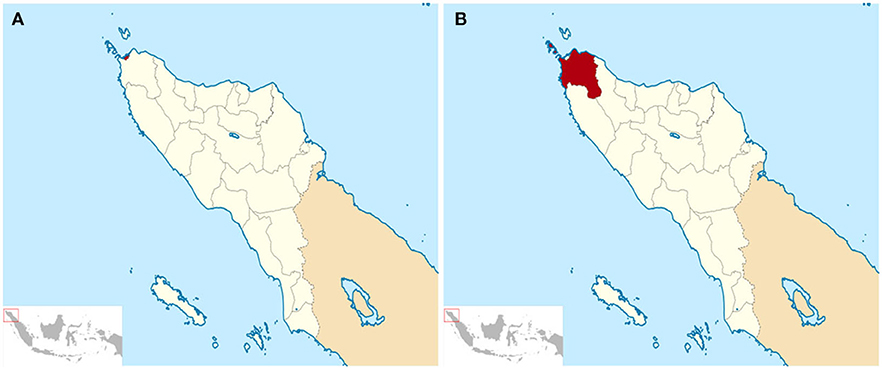
Figure 1. Study area where the data collection was conducted. Banda Aceh District (A) and Aceh Besar District (B), Aceh Province, Indonesia. Available online at: https://id.wikipedia.org/wiki/Berkas:Lokasi_Aceh_Kota_Banda_Aceh.svg and https://id.Wikipedia.org/wiki/Ber-kas:Lokasi_Aceh_Kabupaten_Aceh_Besar.svg.
A total of 9 farmers, 23 traders, and 22 consumers were involved in this study. The small sample size is due to the limited number and willingness of respondents to be involved in research activities. There were limitations of researchers in reaching the location of Aceh cattle farms, also causing the low number of farmers interviewed. Also, the limited number of traders selling Aceh cattle and consumers who bought meat during the survey period was also related to the small number of respondent traders and consumers.
All breeders interviewed were from the community farm groups that raised about 1–10 cattle (small and medium scale) (Alarcon et al., 2017). Cattle meat traders and consumers interviewed represented six traditional meat markets (Peunayong Market, Seutui Market, Lambaro Market, Ulee Kareng Market, Beurawee Market, and Lamnyong Market). Consumers were interviewed after they bought meat in six traditional markets. Data collection is conducted through interviews and observations using a structured questionnaire. Secondary data are also obtained from related literature.
Questionnaire Making
The questionnaire was prepared based on information (perception) requested from farmers, traders, and consumers about the advantages and disadvantages of the Aceh cattle business and meat consumption. The questions such as the reasons why the farmer, trader, and consumer choose Aceh cattle and the beef, what the profits are from Aceh cattle selling, and the reason for consumers' interest or preference in consuming Aceh beef were collected and elaborated in the form of a questionnaire.
Strengths, Weaknesses, Opportunities, and Threats Analysis
Data obtained from interviews using questionnaires and relevant literature (secondary data) were tabulated using Microsoft Excel 2013. Data were grouped into internal factors, which were the strengths and weaknesses, and external factors, which were the opportunities and threats factors. The data were presented descriptively and analyzed using a SWOT analysis.
The next step was to quantify qualitative data (strengths, weaknesses, opportunities, and threats) that have been identified through the SWOT analysis calculation method (Chang and Huang, 2006; Bull et al., 2016; Petkov et al., 2018). The SWOT quantification for each factor was carried out as follows: each respondent's answer for each question was scored, and then the score was calculated in total; then the total scores of each question were grouped into three categories. The categories were 1 = not important (if the total score <10), 2 = less important (if the total score was 10–15), and 3 = most important (if the total score > 15), and then the group results were presented in average scores. Average score were obtained for each SWOT factor. Furthermore, the x value was the difference average score between the S and W factors (x = S – W). The value was the difference average score between O and T factors (y = O – T). The x value and y value were used as the x and y coordinates (x, y), respectively. The coordinates (x, y) showed the position in the SWOT quadrant in the Cartesian field; and from the quadrant position, the current condition of Aceh cattle can be identified to get further improvement recommendations.
The positions in the Cartesian coordinate system are divided into four quadrants (Figure 2), namely, quadrant I, quadrant II, quadrant III, and quadrant IV. Quadrant I (x positive, y positive) shows that business has the power to carry out offensive strategies such as concentration, innovation, and diversification. Quadrant II (x negative, y positive) shows that business conditions have the opportunity to develop a reorientation strategy with vertical integration and conglomerate diversification. Quadrant III (x negative, y negative) shows that a coping strategy can be used to reduce risk by reducing liquidation. Quadrant IV (x positive, y negative) shows that a business not only has competitive power but also faces a threat that is more significant than the existing opportunities. The defense strategy is carried out through horizontal integration and concentric diversification (Petkov et al., 2018).
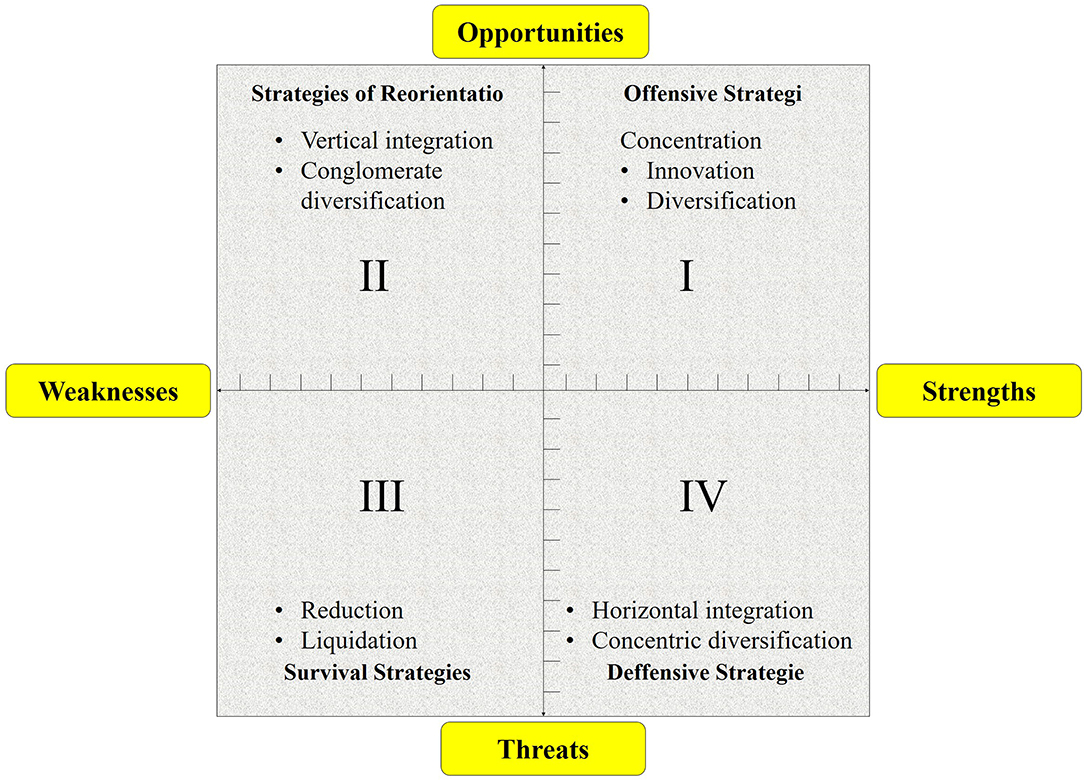
Figure 2. Coordinate the model of strategic options [modification from Petkov et al. (2018)].
Results
Characteristics of Respondents
The characteristics of the respondents as key actors of the Aceh cattle development study (Figure 3) are based on gender, age, and educational background. Farmer's respondent characters in this study were 30–55 years old, were male, and have an educational background from elementary school to university. Trader respondent's characters also consisted of men, with ages ranging from 28 to 55 years, and have educational experience from elementary school to university. Consumer respondent's characters consisted of 20 women and two men, ranging in age from 30 to 55 years, and have educational backgrounds from junior high school to university.
Table 1 shows the information provided by farmers, traders, and consumers about the management system and Aceh cattle business. The results show that Aceh cattle still have their own place for the Aceh people. Farmers still want to raise Aceh cattle (66.67%) because the demand for Aceh beef was still very high (90.91%). The other breeds chosen by the local farmers were Brahman Cross (BX) and Simmental cattle (33.33%). The farming management still used the traditional system with grass and banana stems as a type of feeding (44.44%), without giving additional concentrate or feed additives. The selling system of Aceh cattle was based on estimated of carcass weights through visual observations by traders or collectors (100%). Consumers prefer to consume Aceh beef because it tastes good and sweet (66.67%), although the price was more expensive than that of the other types of beef (77.27%).
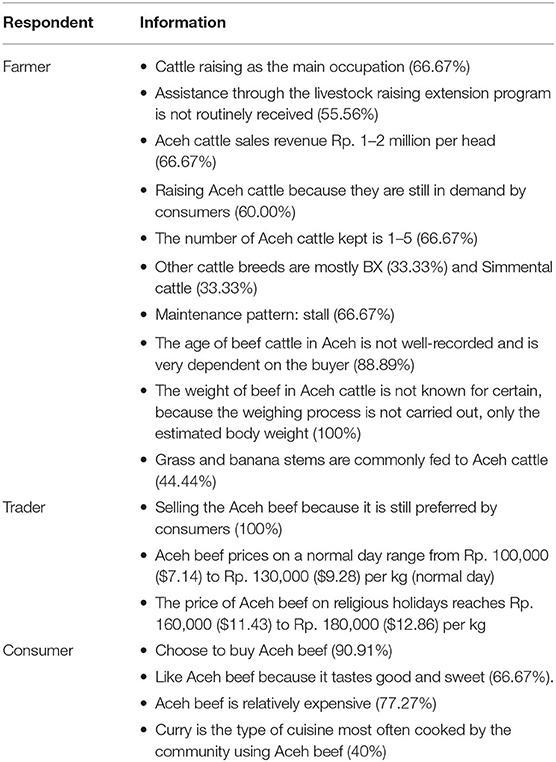
Table 1. The survey results with the highest percentage provided by farmers, traders, and consumers.
On the normal days, the price of Aceh beef during the study period ranged from Rp. 100,000 ($7.14) to Rp. 130,000 ($9.28) per kg; but on a religious holiday, the prices of Aceh beef increased to Rp. 160,000 ($11.43) to Rp. 180,000 ($12.86) per kg. The high selling price of Aceh beef caused some consumers to buy other than Aceh beef. Curry was the type of dish that was most often cooked by consumers. Curry was a type of dish made from beef or chicken that was cooked at high temperatures and a long time. Therefore, Aceh beef was a suitable type of beef for Aceh people cuisine (40%).
Results of the Strengths, Weaknesses, Opportunities, and Threats Analysis
Figure 4 shows the SWOT matrix and the factors of the SWOT to the economic potential of Aceh development based on the perspectives of farmers, traders, and consumers. The main strengths of Aceh cattle development were the high demand for Aceh cattle from traders due to high consumer preferences for Aceh beef, the easier process of raising Aceh cattle, the delicious and sweet taste of meat, and suitability for Aceh traditional cuisine. The main weakness factors were low body weight gain, the traditional Aceh cattle selling system, traditional maintenance, and farming management that leads to the decreasing patterns of the Aceh cattle population.
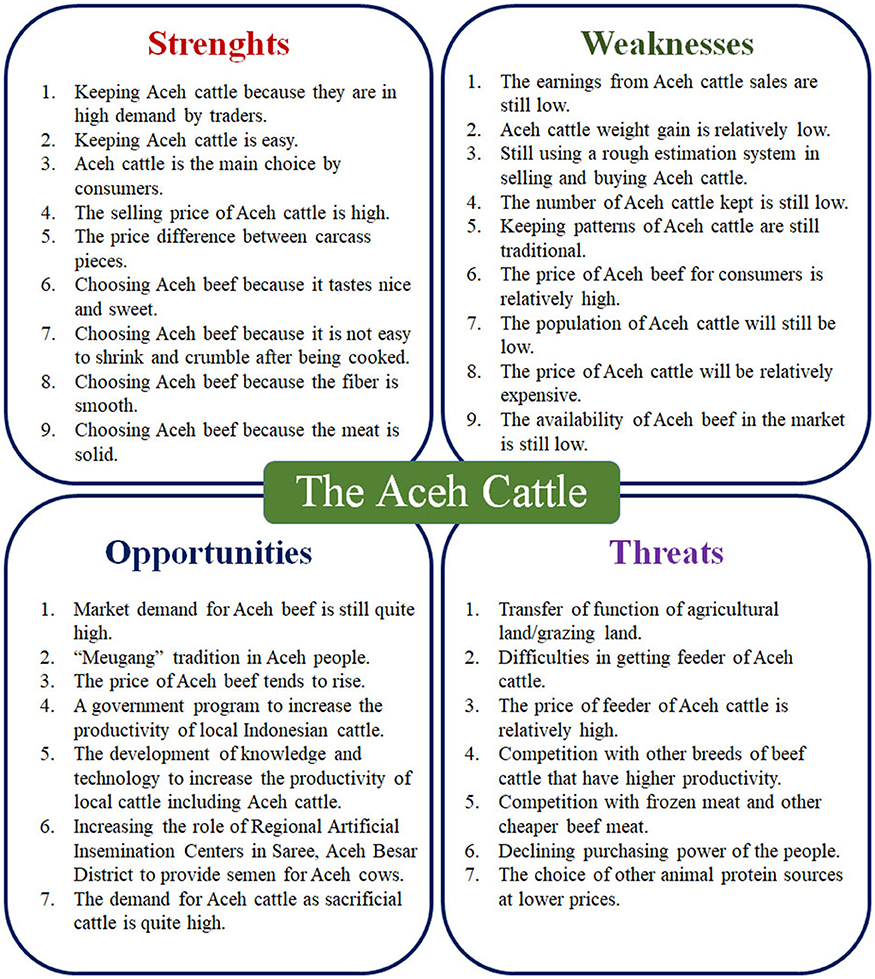
Figure 4. The SWOT (strengths, weaknesses, opportunities, and threats) matrix for identifying the strengths, weaknesses, opportunities, and threats to the economic potential of Aceh development based on the perspective of farmers, traders, and consumers.
Opportunities to maximize the economic potential of Aceh cattle were still quite high. The opportunity factors include the high demand by the community, the existence of the “Meugang” tradition in Aceh local society, and Aceh cattle as sacrificial animals for religious purposes. The “Meugang” tradition is the tradition of slaughtering goat or cattle, which is done three times a year (1–2 days before Ramadhan, Eid al-Fitr, and Eid al-Adha). The main threats faced by the Aceh cattle business included difficulty in Aceh cattle breeding, so the price of the calves is relatively high; competition with other cattle breeds that have higher productivity; and the decrease of purchasing power of the consumer.
The SWOT quantification is presented in Table 2. The average score for strength, weakness, opportunity, and threat was 2.56, 2.44, 2.14, and 2.43, respectively. The difference between S and W (x) was 0.12, and the difference between O and T (y) was −0.29, so the x, y coordinates on the Cartesian field were (0.12–0.29). These coordinates indicated that the current condition of Aceh cattle development was in quadrant IV (Figure 5), which means that the Aceh cattle business is facing tough challenges, so various strategies are needed to meet the challenges.
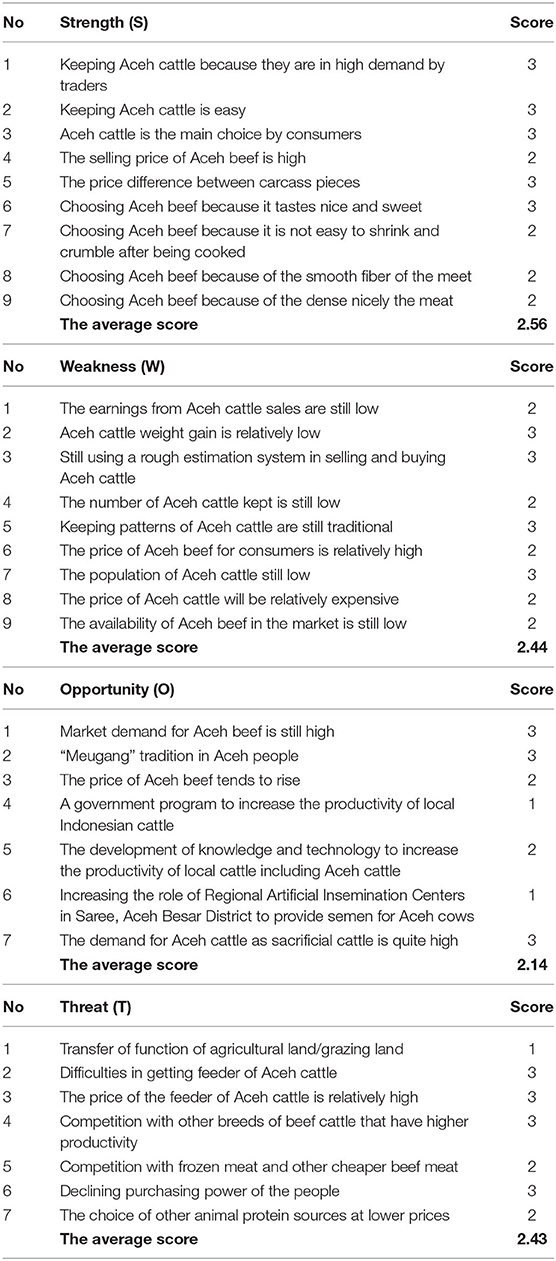
Table 2. The results of the quantification SWOT (strengths, weaknesses, opportunities, and threats) analysis of the economic potential of Aceh cattle are based on farmers, traders, and consumers' perceptions.
Discussion
Table 2 and Figures 4, 5 show that from the perspective of farmers, traders, and consumers, Aceh cattle still have the economic potential to be developed because the strength factors were still higher than the weakness factors. However, the SWOT quantification indicated that Aceh cattle development currently faces significant challenges (Table 2 and Figure 5). It can be seen from the data that the threat factor was higher than the opportunity factor. Several strength factors have been identified, such as raising Aceh cattle is relatively easy due to their fairly good adaptation to the rearing environment, due to high selling prices, and because Aceh beef is still the favorite choice for consumers. Based on the consumer perspectives, Aceh beef has a delicious and sweet taste, does not shrink easily after cooking, and has smooth and dense fiber. It is very suitable for Acehnese traditional cuisine, because it is cooked well-done with the wet cooking method. Theoretically, the sweet taste in meat is influenced by the high muscle glycogen content, which causes a sweet taste in meat. However, measurements of muscle glycogen levels were not performed in this study.
The factors that became strengths were still able to cover all the existing weaknesses. The relatively low increase in body weight of Aceh cattle is predicted to have been influenced by traditional rearing system. Approximately 44.44% of farmers only gave feed in the form of grass and banana stems (Table 1). The traditional estimation system for determining carcass weights often caused the economic loss for the traders due to incorrect estimation of the amount of the carcass. The traders expect government regulations to require the application of a more accurate weighing system in the Aceh cattle trading process, which has been applied to the Brahman Cross cattle. The large-scale farming system of Aceh cattle business is still rare, so the availability of Aceh cattle was relatively limited. This triggers the high price of Aceh cattle due to the imbalance between supply and demand for Aceh cattle. The high price of Aceh cattle has an impact on the high price of meat sold by traders. The price of Aceh beef was more expensive than the price of other types of beef that are available in traditional markets in Banda Aceh City and Aceh Besar District. Currently, people's purchasing power has decreased, and it may result in a decrease in beef consumption, especially for Aceh beef. In this study, we found that the farmers still have a high interest in raising Aceh cattle, despite the existing problems, because the strength factors covered up the weakness factors. However, the high demand for Aceh beef has not been related to the imbalance in breeding programs and quality improvement programs of the breed (Putra et al., 2015).
The opportunity factors for Aceh cattle development were still quite high but have not been able to overcome the existing threats. Three main opportunities were identified in this study, such as the high market demand for Aceh beef, “Meugang” tradition, and the high demand for Aceh cattle as sacrificial animals. The need for Aceh beef is higher during the “Meugang” activity than normal day consumption. The “Meugang” tradition in Aceh gives a very good potential for the development of Aceh cattle in the future. The Aceh people are known to be very enthusiastic about carrying out activities related to cultural and religious aspects. The high demand for Aceh cattle as sacrificial animals is also a very good opportunity. The demand for Aceh cattle as sacrificial animals was high because it was cheaper than other breeds. It is related to the size of the Aceh cattle. On the other hand, the high demand for Aceh cattle as sacrificial animals caused the limitation of Aceh beef availability in traditional markets.
The identified opportunities have been not enough to cover up the threats. Some of the threats were the difficulty of the breeding system that also caused the high process of the calves and competition between Aceh cattle and other breeds such as Brahman Cross cattle and Ongole Grade (PO) cattle. The low purchasing power of the people could pose a threat to the consumption of Aceh beef as a source of animal protein. The data showed that there is a decrease in demand for beef by Aceh people. Likewise, the average meat consumption of Aceh people (combined urban and rural society) in 2018 only reached 2.05 g per day per capita. This amount is far below the average consumption of fish/squid/shrimp/shellfish, which reached 13.26 g per day per capita (Statistics of Aceh Province, 2020). The performance of Aceh cattle from the smallholder farms was not optimal because of the traditional management system. The Aceh Indrapuri Cattle Breeding Center as government agencies that function as a provider of superior Aceh cattle breeds for the community can enhance Aceh cattle performance and showed better results of Aceh cattle performance, which have a higher body weight than Aceh cattle that are kept by smallholder farmers. This means that Aceh cattle raised by farmers can still increase in growth with a more intensive maintenance management system.
The results showed that the economic potential of Aceh cattle development was in quadrant IV (Figure 5). This showed that the Aceh cattle business has competitive strength but faces some threats that were higher than the opportunities. Stakeholders need to facilitate the implementation of the various strategies for the development of Aceh cattle. This study showed different results compared with the previous studies that identified Aceh cattle development in quadrant I, which means that Aceh cattle have significant strength and did not receive significant external threats (Hanani and Jamilah, 2011). The changes in Aceh cattle development occurred as time goes by related to the exposure of various factors. The changes could lead to an increase or decrease in the Aceh cattle business. Based on the SWOT analysis, the strength factor was still superior (average score: 2.56) compared with the weakness factor (average score: 2.44). However, the threat factor was higher (average score: 2.43) than the opportunity factor (average score: 2.41). Based on this condition, the threats must be minimized so that the opportunity factor can be optimized without significant threats and can be utilized in increasing the Aceh cattle business.
The main challenge of the Aceh cattle development program in the future also comes from the government side. The government's attention and commitment, especially the Aceh Province Government, to the development of Aceh cattle as one of Indonesia's local beef cattle must be further enhanced. The government must ensure the availability of Aceh cattle breeds so that the price of Aceh cattle is affordable by farmers and can provide maximum benefits for them. The government must create creative innovations to increase the demand for Aceh cattle. The Aceh beef has several advantages than other kinds of beef, namely, the sweet taste of the meat and its suitability for traditional Acehnese dishes. Because the feeding system is only grass and concentrate is not given, the fat content of beef is relatively low (Vestergaard et al., 2000). This can be promoted as another advantage of Aceh beef. Along with the increasing public awareness of healthy food, Aceh beef can become a healthy food choice. The other program able to be created by the government to promote Aceh cattle is holding livestock festivals, livestock fairs, cooking competitions using Aceh beef, and mass campaigns to increase the popularity of Aceh cattle. The campaign is expected to increase public awareness about the ease of raising Aceh cattle and can promote the Aceh beef, which has a delicious taste at affordable prices. In line with the increasing popularity of Aceh cattle in society, the government should also encourage researchers and provide financial support for studies on increasing the productivity, reproduction, and quality of Aceh beef. Also, economic calculation data on the Aceh cattle business, especially those related to functional characteristics (health, reproduction, and production periods) and feed efficiency, need to be socialized to the farmers so that they can choose the desired business scale based on their capital. Currently, economic analysis data for Aceh cattle business with various business scales are not yet available, so that farmers and traders do not have a vision in developing their business.
Several managerial implications serve as a strategy for Aceh cattle development, namely, campaign for the advantages of Aceh cattle such as easiness, does not require a long time to raise, and less feed amount because Aceh cattle are small cows. Farmers are not advised to change traditional rearing management to an intensive system, especially in the type of feed. Feeding systems that only provide grass without concentrate will produce meat that is low in fat. All the advantages of Aceh cattle must be maintained. Farmer's education on the breeding management system of Aceh cattle is very important to do. The farmers should know how to prevent inbreeding and crossbreeding to preserve the genetic sustainability of Aceh cattle, through either natural mating or artificial insemination. This education aims to make farmers indirectly play an active role in preserving Aceh cattle germplasm, which is the target of conservation as local Indonesian breed cattle. The challenge for Aceh cattle extinction at this time is that the Aceh cattle slaughter rate is still high and uncontrollable (Zulyazaini et al., 2016) and the crossbreeding of Aceh cattle with other breeds through artificial insemination is still quite high.
Preservation of genetic resources, increasing genetic quality, and increasing productivity can be done to prevent extinction (Kristensen et al., 2015) and at the same time increase the economic value of Aceh cattle. Molecular genetic characterization in several breeds of local Indonesian cattle has been successfully carried out, including Aceh cattle. Although genetically, the productivity of exotic cattle breeds is difficult for local cattle to catch, the optimization of the potential of local beef cattle must be maximized. The national improvement program for Indonesian local beef cattle still requires a lot of research, so it is hoped that the genetic conservation of local cattle can be carried out with supporting data for the preservation of the germplasm of Indonesian domestic cattle. Several studies related to local beef cattle in Aceh Province, Indonesia, are presented in Table 3.
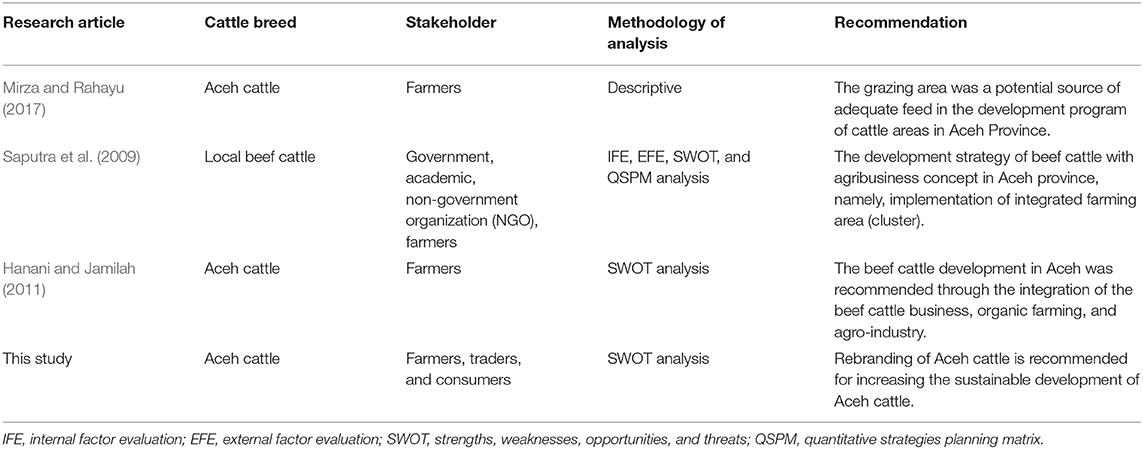
Table 3. Summary of the research related to local beef cattle development in Aceh Province, Indonesia.
The Aceh cattle rebranding program as the healthy meat is also an important factor to be carried out by various stakeholders in a good synergy so that the Aceh cattle business can be sustainable and bring more benefits to stakeholders as well as for the Aceh cattle itself. The rebranding program can increase consumer demand for Aceh cattle and beef that will also increase the interest of breeders and traders to raise and sell Aceh beef. Indirectly, breeders, traders, and consumers take part in the conservation program for the germplasm of Indonesian local beef cattle. A schematic knowledge framework for Aceh cattle development through the elaboration of a SWOT analysis on the economic potential of Aceh cattle is represented in Figure 6.
The weakness of this study is that the new study location covers two out of 23 districts/cities in Aceh Province. Although the authors believe that the data collected in this study are sufficiently representative to describe the economic potential of Aceh cattle based on the perspectives of farmers, traders, and consumers, the coverage of the study area is still lacking. Research data related to the superiority of Aceh beef are only based on consumer perceptions and have not been supported by laboratory research. Therefore, studies on Aceh cattle must be reproduced and analyzed comprehensively.
Conclusion
Currently, the condition of Aceh cattle farm is facing major challenges as shown in the results of the SWOT analysis. The accurate strategy from the stakeholder perspective must be implemented immediately. Several strategies were identified in this study, such as increasing the number of superior seeds through genetic selection, assessing the correct carcass weight through a modern and accurate weighing system, optimizing productivity through improving the quality and quantity of feed, and giving recommendations to the government to make regulations to support Aceh cattle development program. Finally, future work has been planned for increasing Aceh cattle demand by rebranding the program. This program must involve the local and central government, academics, industry, practitioners, and financial institutions. The Aceh cattle rebranding process should be done as an effort to increase the interest of local farmers in the Aceh cattle breed as well as to increase Aceh beef consumption. These strategies will also strengthen the efforts to preserve Aceh Cattle as one of Indonesia local breeds by the participation and synergy of the stakeholders. All of the strategies are needed to support the sustainable development of Aceh cattle. The results of the study can be used as basic data and guidance for the government to make proper policy and regulation to maximize the economic potential of Aceh cattle in the future based on the perspective of breeders, traders, and consumers without disregarding environmental, social, and animal welfare aspects.
Data Availability Statement
The raw data supporting the conclusions of this article will be made available by the authors, without undue reservation.
Ethics Statement
The studies involving human participants were reviewed and approved by Institute of Research and Community Empowerment of IPB University and obtained permission from the Provincial Government Aceh. The participants provided their written informed consent to participate in this study.
Author Contributions
HS, AS, CS, SA, and ES designed the study, contributed to the analyses, and drafted the manuscript. SA and ES reviewed the results and drafted the manuscript. The manuscript has been read and approved by all authors.
Funding
The work was funded by the Indonesia Endowment Fund for Education (Indonesian: Lembaga Pengelola Dana Pendidikan/LPDP) through the Ministry of Research, Technology, and Higher Education Number: PRJ-6191/LPDP.3/2016.
Conflict of Interest
The authors declare that the research was conducted in the absence of any commercial or financial relationships that could be construed as a potential conflict of interest.
Acknowledgments
The authors would like to thank all stakeholders for their participation in this study. The authors also would like to pay special regards to Dr. Hendra Saputra S.Pt., MM, for his help during sampling and providing the authors and their student with insight regarding Aceh cattle farms.
References
Abdullah, M. A. N., Noor, R. R., Martojo, H., and Solihin, D. D. (2008). Genetics characterization of Aceh cattle utilizing microsatellite DNA analysis. J. Indon. Trop. Anim. Agric. 33, 165–175. doi: 10.1111/j.1439-0531.2011.01959.x
Abdullah, M. A. N., Noor, R. R., Martojo, H., Solihin, D. D., and Handiwirawan, E. (2007). The phenotypic variability of Aceh cattle in Nanggroe Aceh Darussalam. J. Indon. Trop. Anim. Agric. 32, 11–21.
Alarcon, P., Fevre, E. M., Muinde, P., Murungi, M. K., Kiambi, S., Akoko, J., and Rushton, J. (2017). Urban livestock keeping in the city of Nairobi:diversity of production systems, supply chains, and their disease management and risks. Front. Vet. Sci. 4:171. doi: 10.3389/fvets.2017.00171
Bull, J. W., Jobstvogt, N., Bohnke-Henrichs, A., Mascarenhas, A., Sitas, N., Baulcomb, C., et al. (2016). Strengths, weakness, opportunities and threats: a SWOT analysis of the ecosystem services framework. Ecosyst. Serv. 17, 99–111. doi: 10.1016/j.ecoser.2015.11.012
Chang, H. H., and Huang, W. C. (2006). Application of a quantification SWOT analytical method. Math. Comput. Model 43, 158–169. doi: 10.1016/j.mcm.2005.08.016
Datta, N. R., Kok, H. P., Crezee, H., Gaipl, U. S., and Bodis, S. (2020). Integrating loco-regional hyperthermia into the current oncology practice: SWOT and TOWS analyses. Front. Oncol. 10:819. doi: 10.3389/fonc.2020.00819
Gorener, A., Toker, K., and Ulucay, K. (2012). Application of combined SWOT and AHP: a case study for a manufacturing firm. Proc. Soc. Behav. Sci. 58, 1525–1534. doi: 10.1016/j.sbspro.2012.09.1139
Hanani, N., and Jamilah (2011). Kelayakan dan stategi pengembangan sapi potong untuk pengentasan kemiskinan di Aceh. JAM. 9, 474–480.
Ibeagha-Awemu, E. M., and Zhao, X. (2019). Epigenetic marks: regulators of livestock phenotypes and conceivable sources of missing variation in livestock improvement programs. Front. Genet. 6:302. doi: 10.3389/fgene.2015.00302
Kristensen, T. N., Hoffmann, A. A., Pertoldi, C., and Stronen, A. V. (2015). What can livestock breeders learn from conservation genetics and vice versa? Front. Genet. 6:38. doi: 10.3389/fgene.2015.00038
Ministry of Agriculture Republic of Indonesia [MoA]. (2011). Decree of the Minister of Agriculture of the Republic of Indonesia Number 2907 of 2011 Concerning the Establishment of Aceh Cattle Breed. Jakarta: Ministry of Agriculture.
Mirza, I., and Rahayu, W. (2017). The model of development the Aceh cattle in Aceh Jaya district of Aceh province. JPI. 19, 152–160. doi: 10.25077/jpi.19.3.152-160.2017
Otte, J., Pica-Ciamarra, U., and Morzaria, S. (2019). A comparative overview of the livestock-environment interactions in Aisa and Sub-saharan African. Front. Vet. Sci. 6:37. doi: 10.3389/fvets.2019.00037
Petkov, R., and Bankatev, I. (2018). Using a vector SWOT-analysis to determine the guidelines for the training of tracked vehicles driver in the Bulgarian army. Int. Conf. Knowl. 24, 334–339. doi: 10.1515/kbo-2018-0054
Putra, W. P. B., Sumadi, Hartatik, T., and Saumar, H. (2015). Early selection for Aceh candidate bull based on body weight. JSPI. 10, 7–12. doi: 10.31186/jspi.id.10.1.7-12
Rahmatullah, S. N., Sulaiman, A., Askalani, and Azizi, N. M. K. (2018). Prospect development of local beef cattle from South Kalimantan as supporting to food sovereignity in Indonesia. IOP Conf. Ser. Earth Environ. 144:012016. doi: 10.1088/1755-1315/144/1/012016
Roessali, W., Masyhuri, Nurtini, S., and Darwanto, D. H. (2010). “Performance and foresight of beef cattle development in Central Java” in The 5th International Seminar on Tropical Animal Production: Community Empowerment and Tropical Animal Industry (Yogyakarta).
Saputra, H., Daryanto, A., and Hendrawan, D. S. (2009). Development strategy of beef cattle with agribusiness concept in Aceh province. JMA. 6, 152–162.
Sari, E. M. (2011). Genetic Polymorphism of Growth Hormone (GH) in Association With Carcass Quality of Aceh cattle. (Doctoral dissertation). IPB University, Bogor.
Shinno, H., Yoshioka, H., Marpaung, S., and Hachiga, S. (2006). Quantitative SWOT analysis on global competitiveness of machine tool industry. J. Eng. Design 17:3. doi: 10.1080/09544820500275180
Silalahi, F. R. L., Rauf, A., Hanum, C., and Siahaan, D. (2019). SWOT analyisis of development of beef cattle-palm oil integration in Indonesia. IOP Conf. Ser. Earth Environ. 347:012105. doi: 10.1088/1755-1315/347/1/012105
Statistic Indonesia [SI] (2019). Available online at: https://www.bps.go.id/publikasi.html (accessed August 26, 2019).
Statistics of Aceh Province (2019). Aceh Province in Figures 2019. Available online at: https://aceh.bps.go.id/publication/2019/08/16/c874b8b17e60e74da57b8501/provinsi-aceh-dalam-angka-2019.html (accessed August 25, 2019).
Statistics of Aceh Province (2020). Pengeluaran Rumah Tangga Provinsi Aceh. Available online at: https://aceh.bps.go.id/publication/2020/04/13/dd9215f0d515885722943ff6/statistik-pengeluaran-rumah-tangga-provinsi-aceh-2019.html (accessed September 5, 2020).
Vestergaard, M., Therkildsen, M., Henckel, P., Jensen, L. R., Andersen, H. R., and Sejrsen, K. (2000). Influence of feeding intensity, grazing and finishing feeding on meat and eating quality of young bulls and the relationship between muscle fibre characteristics, fibre fragmentation and meat tenderness. Meat Sci. 54, 187–195. doi: 10.1016/s0309-1740(99)00098-4
Keywords: Aceh cattle, livestock, stakeholder's perspective, smallholder, SWOT analysis
Citation: Sofyan H, Sudarnika E, Satyaningtijas AS, Sumantri C and Agungpriyono S (2020) The Economic Potential of Aceh Cattle Based on Its Farmers, Traders, and Consumers Perspective. Front. Sustain. 1:546177. doi: 10.3389/frsus.2020.546177
Received: 04 June 2020; Accepted: 29 October 2020;
Published: 26 November 2020.
Edited by:
Mitali Sarkar, Yonsei University, South KoreaReviewed by:
Bikash Koli Dey, Hongik University, South KoreaSharmila Saren, Government General Degree College, India
Rekha Guchhait, Yonsei University, South Korea
Copyright © 2020 Sofyan, Sudarnika, Satyaningtijas, Sumantri and Agungpriyono. This is an open-access article distributed under the terms of the Creative Commons Attribution License (CC BY). The use, distribution or reproduction in other forums is permitted, provided the original author(s) and the copyright owner(s) are credited and that the original publication in this journal is cited, in accordance with accepted academic practice. No use, distribution or reproduction is permitted which does not comply with these terms.
*Correspondence: Etih Sudarnika, ZXRpaEBhcHBzLmlwYi5hYy5pZA==
 Hamny Sofyan
Hamny Sofyan Etih Sudarnika
Etih Sudarnika Aryani S. Satyaningtijas4
Aryani S. Satyaningtijas4